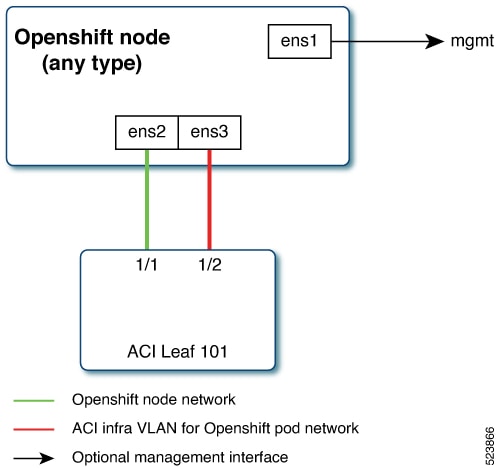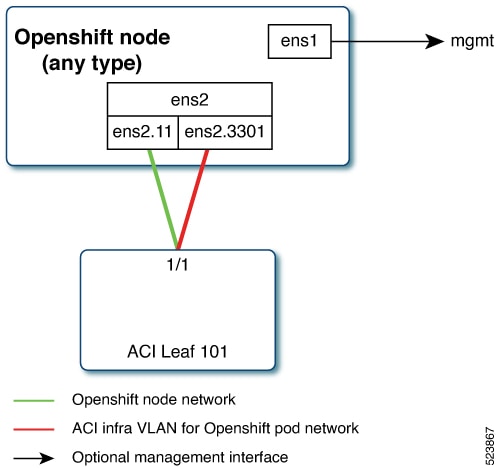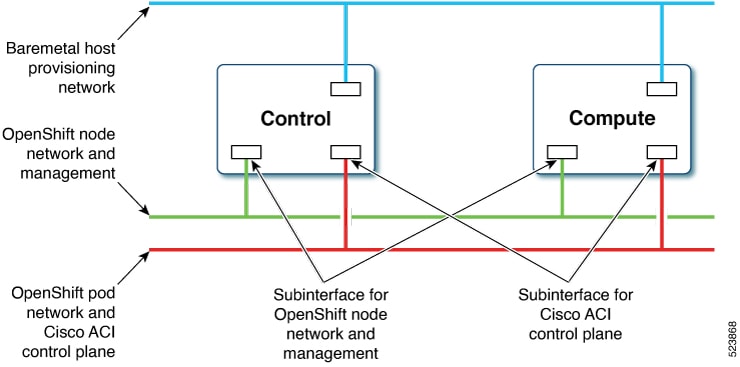New and Changed Information
The following table provides an overview of the significant changes up to this current release. The table does not provide an exhaustive list of all changes or of the new features up to this release.
|
Cisco ACI CNI plug-in Release Version |
Feature |
|---|---|
|
6.0(4) |
Cisco Application Centric Infrastructure (ACI) supports Red Hat Agent-based OpenShift on a bare metal server. |
Agent-based Openshift 4.14 on Bare Metal
This document pertains to installing OCP with the ACI CNI. However, to identify and resolve issues in your infrastructure not related to the ACI CNI, see the relevant installation guide to first install OCP on your bare metal nodes using the default OVN Kubernetes. You can check the OpenShift 4.14 container platform documentation.
 Note |
This document can not be used standalone. This document should be used along with the Red Hat OpenShift 4.14 Installing an on-premise cluster with the agent-based installer document to perform the OpenShift cluster installation. |
Requirements for supporting OpenShift 4.14 on a Bare Metal Server
At least two network interfaces are required for bare metal nodes, one for the node network, and the second for the pod network. The design separates OpenShift node traffic from the pod traffic. There are two options available to achieve separation, resulting in control and compute machines each having two network interfaces:
-
Separate physical interface for node and infra networks
-
Single Sub interface for both node and infra networks
Separate physical interface for node and infra networks

The first interface is used for the node network and the second one is used for the pod network. The second interface also carries Cisco ACI control plane traffic. A VLAN tagged subinterface can be configured on the second interface to carry the cluster's pod traffic and also the Cisco ACI control plane traffic.
Single Sub interface for both node and infra networks

The node network and pod network are configured as VLAN subinterface of either bond0 or physical NIC. You can configure the server with additional VLAN(s) for management purpose or use the node network for management network. The design might be dependent on the server provisioning method (PXE or manual ISO boot).
Installation Process
The following sections detail the steps required to install the OpenShift cluster using the ACI CNI.
The image below illustrates the various types of networks utilized in the installation process.
At least two network interfaces are necessary for bare metal nodes: one for the node network and the other for the pod network. This design segregates OpenShift node traffic from pod traffic. A third interface is configured for the private network, essential for provisioning bare metal hosts.

Configuring the OpenShift Installer
Use this procedure to configure the OpenShift installer. The installation will use a 3 node-cluster (control will have scheduling enabled). For scaling nodes post installation, see the section, Scaling Agent-Based Installation with the Bare Metal Operator.
Before you begin
Download the OpenShift installer and OC client.
For details of the location from where you can download the installer , see the OpenShift 4.14 document titled, Installing an on-premise cluster with the Agent-based Installer.
Procedure
|
Step 1 |
Create the |
|
Step 2 |
Create the |
Configuring ACI Infra and CNI
Use this procedure for configuring ACI infra and CNI using acc-provision.
Procedure
|
Sample ACI configuration:
Customize the sample This generates a new |
Preparing Custom Network Configuration for OpenShift Nodes
ACI CNI requires additional VLANs to be extended towards each OpenShift node. Additional VLANS are required for all master and worker nodes.
You can configure additional VLANs on the interface that will be configured with the node network subnet or can be configured on an additional physical interface on the hosts.
The available option to configure a network interface of a host is to provide the configuration in agent-config.yaml in NMState format. For details about creating agent-config.yaml , see the Configuring the OpenShift Installer section.
Modifying the agent-config file
Use this procedure to modify the agent-config.yaml file.
Before you begin
The agent-config file, with additional NIC configuration, needs to extend the Cisco ACI internal network (Infra VLAN) up to the server level. This interface is used to carry VxLAN traffic from OVS towards the ACI leaf switch with an appropriate tag for the pod network. To achieve the separation between the OpenShift node traffic and pod traffic, use the Single Sub interface for both node and infra networks approach. The relevant details have been discussed in the Requirements section.
The following YAML snippet outlines an AgentConfig. It includes essential details like rendezvous IP, host configurations, and network interface settings for streamlined deployment.
apiVersion: v1alpha1
kind: AgentConfig
metadata:
name: ocpbm1
rendezvousIP: 192.168.1.3. -> A
AdditionalNTPSources:
- time.cisco.com
hosts: -> B
- hostname: ocpbm1-master1 -> C
role: master
interfaces:
- name: ens160
macAddress: 00:50:56:97:16:db
networkConfig: -> D
interfaces:
- name: ens160
mtu: 9000
ipv4:
enabled: false
ipv6:
enabled: false
- name: node
type: vlan
mtu: 9000
state: up
vlan:
base-iface: ens160
id: 11
ipv4:
enabled: true
address:
- ip: 192.168.1.3
prefix-length: 24
dhcp: false
ipv6:
enabled: false
- name: infra
type: vlan
mtu: 9000
state: up
vlan:
base-iface: ens160
id: 3301
ipv4:
enabled: true
dhcp: true
ipv6:
enabled: false
dns-resolver:
config:
server:
- 192.168.1.2
routes:
config:
- destination: 0.0.0.0/0
next-hop-address: 192.168.1.1
next-hop-interface: node
- destination: 224.0.0.0/4
next-hop-interface: infra
In the above sample, sections have been marked as A, B, C, D. Here are the details for better understanding.
-
A: This IP address is used to determine which node performs the bootstrapping process as well as running the assisted-service component. You must provide the rendezvous IP address when you do not specify at least one host’s IP address in the
networkConfigparameter. If this address is not provided, one IP address is selected from the provided hosts'networkConfig. -
B: Host configuration. The number of hosts defined must not exceed the total number of hosts defined in the
install-config.yamlfile, which is the sum of the values of thecompute.replicasandcontrolPlane.replicasparameters. -
C: Overrides the hostname obtained from either the Dynamic Host Configuration Protocol (DHCP) or a reverse DNS lookup. Each host must have a unique hostname supplied by one of these methods.
-
D: Configures the network interface of a host in NMState format.
Procedure
|
Step 1 |
Create a root folder for your cluster. |
|
Step 2 |
Copy the install-config.yaml, agent-config.yaml in the newly created upi folder. |
|
Step 3 |
Create the openshift directory. |
|
Step 4 |
Extract all the ACI manifest files in upi/openshift/. |
|
Step 5 |
Create the iso image. |
|
Step 6 |
Boot the agent.x86_64.iso image on the bare metal machines. The |
Updating the Default Ingress Controller
For updating the default Ingress Controller publish strategy to use the ACI Loadbalancer, log in as a user with cluster-admin privileges and run the following:
oc replace --force --wait --filename - <<EOF
apiVersion: operator.openshift.io/v1 kind:
IngressController metadata:
namespace: openshift-ingress-operator
name: default spec:
endpointPublishingStrategy:
type: LoadBalancerService
loadBalancer:
scope: External
EOF
For more details, see the Configuring the Default Ingress Controller for your Cluster to be Internal section in the Ingress Operator in OpenShift Container Platform Red Hat guide.
Scaling Agent-based Installation with Bare Metal Operator
Use this procedure to add workers or scale nodes in a cluster.
Procedure
|
Step 1 |
Power off the bare metal node by using the baseboard management controller (BMC), and ensure it is off. |
||
|
Step 2 |
Apply configuration file for the bare metal node, use one of the following example bmh.yaml files, replacing values in the YAML to match your environment:
|
||
|
Step 3 |
Check the respective objects created (the required command has been indicated for each object):
|
||
|
Step 4 |
Scale up the number of replicas to match the number of available bare metal hosts: |
 Feedback
Feedback